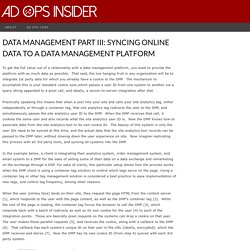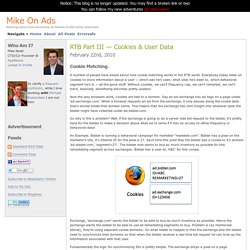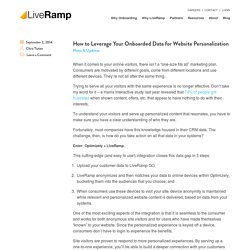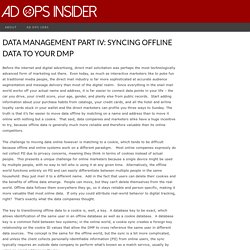

Panorama_trading_desks.png (PNG Image, 2000 × 2440 pixels) - Scaled (41%) DoubleClick Ad Exchange Real-Time Bidding Protocol Découvrez dans les sections suivantes comment le service de lecture des cookies peut vous aider dans vos sélections d'enchères.

Important : Ce document concerne la dernière version (version 2) de l'API du service de lecture des cookies. Si votre application utilise la version 1, référez-vous aux spécifications de la version 1. En quoi consiste le service de lecture des cookies ? Le service de lecture des cookies permet à un acheteur d'associer deux types de données :
Lasso Programming: Tutorial: Understanding Cookies and Sessions. Cookies and Sessions are inextricably intertwined, and fundamental to creating rich, interactive internet applications.

What we will be covering in this tutorial: What is a "cookie" What is a "session" Setting and reading cookies Using sessions Troubleshooting Further reading What is a "Cookie"? A cookie is a small piece of text stored on a user's computer by their browser. Common uses for cookies are authentication, storing of site preferences, shopping cart items, and server session identification.
Each time the users' web browser interacts with a web server it will pass the cookie information to the web server. Data Management Part III: Syncing Online Data to a Data Management Platform - Ad Ops Insider. To get the full value out of a relationship with a data management platform, you want to provide the platform with as much data as possible.

That said, the low hanging fruit in any organization will be to integrate 1st party data for which you already have a cookie to the DMP. The mechanism to accomplish this is your standard cookie sync,which passes a user ID from one system to another via a query string appended to a pixel call, and ideally, a server-to-server integration after that. Practically speaking this means that when a user hits your site and calls your site analytics tag, either independently or through a container tag, that site analytics tag redirects the user to the DMP, and simultaneously passes the site analytics user ID to the DMP. When the DMP receives that call, it cookies the same user and also records what the site analytics user ID is. Tracking Google Analytics users' IDs, DynBiz. No doubt we are lately moving from a 'pageviews' kind of measurement towards a user centric one and that makes sense especially when we have the ability to track users across devices and also offline.
Mike On Ads » Blog Archive » RTB Part III — Cookies & User Data. A number of people have asked about how cookie matching works in the RTB world.

Everybody today relies on cookies to store information about a user — which ads he’s seen, what sites he’s been to, which behavioral segment he’s in — all the good stuff. Without cookies, we can’t frequency cap, we can’t remarket, we can’t track, basically, advertising becomes pretty useless! Web development - What are the differences between server-side and client-side programming? Display Advertising Basics (DSPs, RTB, Ad Exchanges, DMPs) - Pete Kluge. How an Ad is Served with Real Time Bidding (RTB) Havas Media généralise son système DYNauction à la presse, la radio et la vidéo en ligne.
How to Leverage Your Onboarded Data for Website Personalization. When it comes to your online visitors, there isn’t a “one-size fits all” marketing plan.

Consumers are motivated by different goals, come from different locations and use different devices. They’re not all after the same thing. Trying to serve all your visitors with the same experience is no longer effective. Don’t take my word for it – a Harris Interactive study last year revealed that 74% of people got frustrated when shown content, offers, etc. that appear to have nothing to do with their interests. Du Big Data au Smart Data : exploitation des données et ROI. La donnée est au cœur de la révolution du marketing en ligne.

Revision- WJEC- Our World- Year 9.
Ads Guide. SSP, DSP, Ad Exchanges: comment ça marche - AdServers France. Data Management Part IV: Syncing Offline Data To Your DMP - Ad Ops Insider. Before the internet and digital advertising, direct mail solicitation was perhaps the most technologically advanced form of marketing out there.

Even today, as much as interactive marketers like to poke fun at traditional media people, the direct mail industry is far more sophisticated at accurate audience segmentation and message delivery than most of the digital realm. Since everything in the snail mail world works off your actual name and address, it is far easier to connect data points in your life – the car you drive, your credit score, your age, gender, and plenty else from public records. Start adding information about your purchase habits from catalogs, your credit cards, and all the hotel and airline loyalty cards stuck in your wallet and the direct marketers can profile you three ways to Sunday. The truth is that it’s far easier to move data offline by matching on a name and address than to move it online with nothing but a cookie. Whatever the provider, here’s how it works: p850-elmeleegy.pdf. A Strategic Guide to Cross-Platform Marketing.
By Eric Bader, CMO of RadiumOne Marketers have a multi-device conundrum because the consumers they want to connect with distribute their attention between multiple devices.

As connected devices like smartphones and tablets have grown in popularity, marketers have addressed the growth by engaging and acquiring consumer intelligence in silos. As marketers followed audiences to smartphones, they got to know and engage the smartphone consumer. In just two years from 2011 to 2013, smartphone ownership in the U.S. jumped 22 percentage points from 43 percent to 65 percent. Along the way to 65 percent smartphone ownership, smartphone strategies became a must for marketers. As marketers followed audiences to tablets, they got to know and engage the tablet consumer.
Data Management Part III: Syncing Online Data to a Data Management Platform - Ad Ops Insider. SSP to DSP Cookie-Synching Explained - Ad Ops Insider. The matching process of the SSP cookie ID to the DSP cookie ID happens through a parallel process to serving ads called cookie-syncing.

Cookie-syncing is necessary because as a standard security process, web servers of any kind can only request cookies that are set to their own domain. Since the SSP sits between the end-user and all the DSP bidders in a real-time auction however, the DSP needs a way to identify the users it is looking for. How Does Ad Serving Work? - Ad Ops Insider. Interactive ads are everywhere these days, but when it comes to the technical process of getting an ad on the page and how publishers and marketers verify it delivered, not many people can explain what actually happens in detail. Read this article though and you’ll be one of them! Below I’ve detailed step-by-step how a browser gets from the initial call to a publisher’s website to the final ad creative, and when and how each party counts an impression.
You can view a diagram of the ad serving process at the bottom of this post – the numbers in the text refer to the steps labeled in the diagram. Data Management Part II: Centralize and Synchronize Your User Data - Ad Ops Insider. A critical component of any DMP is the ability to centralize your audience data from multiple systems into a single interface. They do this through a NoSQL database management system that imports your data from multiple systems using a match key between each system that they form via, what else, a cookie sync. It sounds complicated but it isn’t. Let’s take an example from the marketer side to explain the concept. Data Management Part I: What Are Data Management Platforms? - Ad Ops Insider. If you’re working in digital advertising today and not losing sleep over your data strategy (or lack thereof), climb out from under your rock and join the rest of us trying to figure out how to leverage the mountain of consumer intent and behavior collecting on the doorstep each day.
From both the marketer and publisher perspective, data isn’t the problem, access is the problem. Each party has access to vast amounts of data, either directly or through 3rd party channels, but centralizing, organizing, analyzing, and segmenting are very difficult for all but the largest companies. Unless you have a pedigreed team that speaks SAS and Oracle, understands how to use an IBM supercomputer, or has a team of PhDs on the payroll, building your own solution to this problem just isn’t realistic.
It just doesn’t exist in the DNA of most advertising companies today, at least not yet.